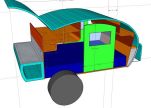Torsion axle location and rating questions.
22 posts
• Page 1 of 2 • 1, 2
Torsion axle location and rating questions.
About ready to order my torsion axle for the "Test Mule" and I have run into a problem that I'm hoping somebody can help me with....
Camper body calculates to 250lbs. Mattress (full innerspring with pillow top) comes in at 100lbs. Cooler mounted to tongue will weigh 100lbs.
Add another 300lbs for battery, spare tire, frame and camping equipment.
Total 750lbs.
My axle is pretty far back, so there will be a large tongue weight (especially with the cooler all the way forward).
My question....what affect does weight distribution have on the axle rating?
Trying to decide if I should order a 550# or a 935#
Either one will have an adjustable "start" angle.
Thanks,
Lee
Camper body calculates to 250lbs. Mattress (full innerspring with pillow top) comes in at 100lbs. Cooler mounted to tongue will weigh 100lbs.
Add another 300lbs for battery, spare tire, frame and camping equipment.
Total 750lbs.
My axle is pretty far back, so there will be a large tongue weight (especially with the cooler all the way forward).
My question....what affect does weight distribution have on the axle rating?
Trying to decide if I should order a 550# or a 935#
Either one will have an adjustable "start" angle.
Thanks,
Lee
-

RockyMountainTeardrops - Super Teardrop Manufacturer
- Posts: 99
- Images: 233
- Joined: Fri Oct 22, 2010 1:28 pm
- Location: 4,000 above Denver, CO
I don't think you're calculating nearly enough weight for your frame, tire and camping equipment. The typical frame is several hundred pounds and a full size spare is 30-50 pounds. Don't forget people weight, too.
The more stuff I take along, the more time I spend taking care of my stuff!
- jstrubberg
- 500 Club
- Posts: 691
- Joined: Tue Nov 08, 2011 8:26 pm
- Location: mid-Missouri





 .......................
.......................